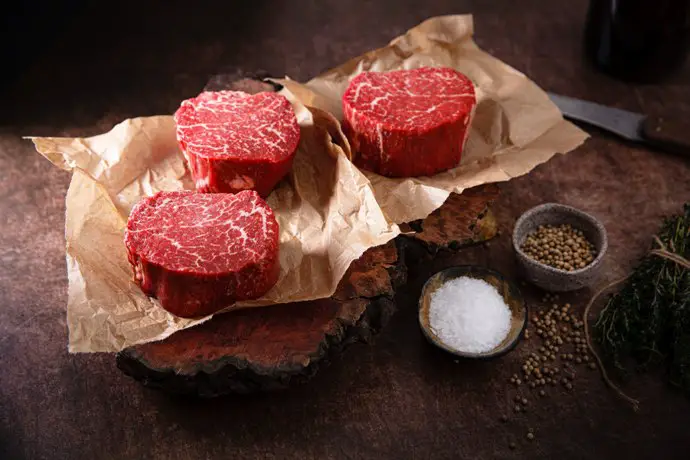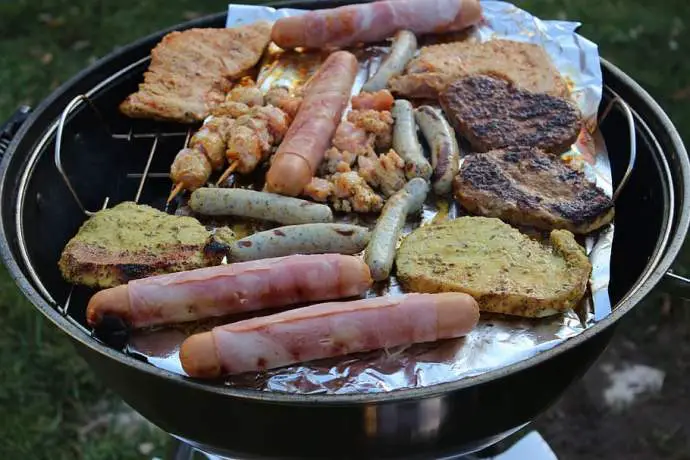If you’re a fan of cured meats, you’ve probably heard of trail bologna and summer sausage.
These two types of sausages have similarities but also distinct differences that set them apart from each other.
In this article, we’ll explore the differences between trail bologna and summer sausage, including their history, ingredients, flavor profiles, and uses.
Table of Contents
Trail Bologna: A Unique Midwest Sausage You Need to Try

This unique sausage hails from Trail, in Ohio’s Amish country. Despite its humble origins, Trail bologna has gained a nationwide reputation for its distinctive flavor and texture.
What Makes Trail Bologna Unique?
In contrast to mass-produced bologna, Trail bologna does not depend on typical fillers like corn syrup, soy protein, or MSG. Instead, it is crafted using straightforward ingredients such as lean beef, salt, pepper, and spices.
Another distinctive feature of Trail bologna is its leanness. Unlike most bologna sausages, which incorporate pork, Trail bologna is exclusively crafted from beef.
How Is Trail Bologna Cooked?
It is a pre-cooked sausage that’s conveniently ready to be enjoyed without any further preparation. Manufacturers cold smoke it for a duration of two to three days to infuse it with a smoky flavor.
>>Read more: Pepperoni vs Sausage.
Summer Sausage: History, Meat, and Cooking

This sausage has its origins in Europe, and it earned the name “summer sausage” because it was originally crafted to be preserved without refrigeration during the warm summer months.
Today, this sausage is relished throughout the year and ranks among America’s favorites.
Beef is the most common meat used in summer sausage, but pork and venison are also used.
The inclusion of pork adds a touch of fat, imparting moisture to the sausage and preventing it from becoming excessively dry. Nonetheless, for those who favor a drier meat, beef-only sausages are also readily available.
Summer sausage is typically seasoned with ingredients like garlic, black pepper, and mustard seeds, although variations incorporating coriander, allspice, or ginger are also available.
Summer sausage can be cooked in various ways. It can be grilled, smoked, or baked, and it can also be added to casseroles or other baking dishes for added flavor.
However, smoking is the best way to bring out its tangy taste.
>>Also read: Salami black spots.
Exploring the Main Differences Between Trail Bologna and Summer Sausage
Meat: The Main Differentiator

One of the most significant differences between trail bologna vs. summer sausage is the type of meat used.
Unlike summer sausage, which can feature an array of meat varieties like chicken, turkey, pork, beef, venison, or blends of two types of meat, Trail bologna is exclusively crafted from high-quality beef.
Moreover, trail bologna is generally thinner and leaner. Some brands also add cheddar cheese to the meat.
In contrast, summer sausage has a higher fat percentage and includes seasonings like ginger, garlic, black pepper, coriander, and clover. The different meat types and seasonings give summer sausage a unique flavor and texture.
Cooking Process
The cooking process is a vital factor that distinguishes trail bologna from summer sausage.
Trail bologna, meticulously crafted by manufacturers, undergoes a process of pre-cooking and cold smoking spanning two to three days. This delectable sausage can be savored directly from the packaging, with options to heat it through microwaving, boiling, or even deep frying, delivering a delightful blend of tangy and smoky flavors.
To prepare, combine spices like paprika, white pepper, garlic, cardamom, etc., with the meat, and smoke them at 140°F, gradually increasing the temperature until the sausages reach 170°F.
In contrast, summer sausage offers versatility in its preparation; it can be grilled, baked, or boiled. However, the most enticing flavor is achieved by smoking it.
To craft delightful summer sausage, keep your smoker’s internal temperature at 160°F and smoke it for a duration of 3 hours. For a two-meat blend of beef and pork, you can opt for a ratio of 25% pork and 75% beef for a leaner choice or 40% beef and 60% pork to create a juicier sausage.
Best Paired With
Both of them are versatile and complement a variety of foods.
Trail bologna pairs wonderfully with savory dishes, but it truly shines when served alongside cheddar cheese. When pan-fried and tucked into a sandwich, it becomes a delectable breakfast delight.
Conversely, summer sausage is an excellent companion to cheese, green salads, and crackers, enhancing the flavor of your sandwiches. It’s also a fantastic addition to BBQ gatherings and leisurely Sunday dinners.
Taste: Earthy or Tangy?
The unique flavor profile of trail bologna is distinguished by its smoky undertones, harmoniously paired with a delightful garlicky and peppery kick. Furthermore, it boasts an enticing earthy essence that tantalizes both the palate and the senses.
On the other hand, summer sausage presents a flavor profile that blends elements of saltiness, spiciness, and tanginess, akin to various other sausage varieties. The tangy quality originates from the fermentation process, which lowers the pH level and subsequently retards bacterial growth within the meat.
This preservation method allows summer sausage to have a longer shelf life without the need for refrigeration.
Serving: Cold or Warm?
Trail bologna is typically served cold, while summer sausage can be enjoyed either cold or warm. Regardless of the serving temperature, both of these cured meats consistently deliver delicious flavors.
Here is a comparison table between Trail Bologna and Summer Sausage:
| Feature | Trail Bologna | Summer Sausage |
| Origin | Ohio, USA | Europe, particularly Germany and Italy |
| Meat | Beef | Beef, Pork or a mixture of both |
| Texture | Coarse and chunky | Smooth and uniform |
| Flavor | Smoky and savory | Mild and slightly tangy |
| Aging | Smoked and aged for several weeks | Dried and fermented for several weeks |
| Serving | Sliced thinly and eaten cold | Sliced thinly and eaten cold or used in cooking |
FAQs

What Makes Bologna Different from Trail Bologna?
The primary difference between regular bologna and trail bologna is the type of meat used. While regular bologna can be made from beef, pork, or turkey, trail bologna is made exclusively from lean beef.
The meat used in trail bologna is also leaner than the meat used in regular bologna.
Additionally, it often has a coarser texture and a smokier flavor due to the way it is traditionally prepared in the Appalachian region of the United States.
Can You Eat the Skin of Ring Bologna?
Yes, you can eat the skin or casing of ring bologna. In fact, all sausage casings are edible, including the natural casings that are typically used for ring bologna.
Natural casings can be made from materials like collagen or fibrous casings, and they are safe to eat. If you bite into the sausage and feel a chewy texture, it could be the casing, but there is no harm in consuming it.
Why is Bologna Bad for You?
One notable concern is that bologna often contains a substantial nitrate, which can have adverse health effects when consumed in excessive quantities. Additionally, bologna is high in both fat and salt.
For instance, a single slice of bologna typically contains roughly 13% of your recommended daily sodium intake.
Conclusion
The main difference between trail bologna vs summer sausage is the meat used and the cooking method, which results in different flavors and textures.
However, both types of sausage are delicious and can be a great addition to your BBQ menu.
Despite their differences, both summer sausage and trail bologna share the similarity of being tasty options for a variety of dishes.
So, don’t hesitate to include them in your next BBQ feast!
Trail Bologna vs, Summer Sausages
summer sausage can be served warm or cold, trail bologna is made only of beef, sausage, sausage, sausage, sausage, sausage, sausage, sausage, sausage, sausage, sausage, sausage, sausage, sausage, sausage, sausage, more, more, more, more, skinless sausages, sausages made, smoking sausages, sausage taste, smoked sausage, sausage making, mix, seasoning, vacuum sealer.

Fernando is the creator and writer behind the food blog Eating with your Hands. Living and working in cities like Paris, Barcelona, and Berlin, and being married to a Canadian foodie, has given Fernando a passion and interest in food and inspired him to run EWYH.
